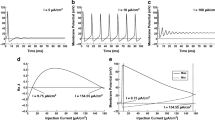Abstract
In this paper, receptor-based cellular nonlinear network model is studied. By applying neural network method, the ordinary differential equations being equivalent to the partial differential equations of the model are resulted. Also, the bifurcation analysis of the transformed system is presented. To support our theoretical results, some numerical examples are given.



Similar content being viewed by others
References
Agranovich G, Litsyn E, Slavova A (2009) Impulsive control of a hysteresis cellular neural network model. Nonlinear Anal Hybrid Syst 3:65–73
Chua LO (1988) CNN: a paradigm for complexity. World Scientific Series on Nonlinear Science, A, 31
Chua LO, Yang L (1988) Cellular neural network: theory and application. IEEE Trans CAS 35:1257–1290
Chua LO, Hasler M, Moschytz GS, Neirynsk J (1995) Autonomous cellular neural networks: a unified paradigm for pattern formation and active wave propagation. IEEE Trans CAS-I 42(10):559–577
Roska T, Chua LO, Wolf D, Kozek T, Tetzlaff R, Puffer F (1995) Simulating nonlinear waves and partial differential equations via CNN—part I: basic techniques. IEEE Trans CAS-I 42(10):807–815
Hoppensteadt F, Jager W (1980) Pattern formation by bacteria. In: Levin S (ed) Lecture notes in biomathematics: biological growth and spread. Springer, Heidelberg
Guidotti P, Merino S (1997) Hopf bifurcation in a scalar reaction diffusion equation. J Differ Equ 140:209–222
Mahecha-Botero A, Garhyan P, Elnashaie SSEH (2004) Bifurcation and chaotic behaviour of a coupled acetylcholinesterase/choline acetyltransferase diffusion-reaction enzymes system. Chem Eng Sci 59:581–597
Slavova A, Markova M (2006) Receptor-based CNN model with hysteresis for pattern formation. In: Proceedings of IEEE, CNNA, pp 241–244
Jianyu L, Siwei L, Yingjian Q, Yaping H (2003) Numerical solution of elliptic partial differential equation using radial basis function neural networks. Neural Netw 16:729–734
He S, Reif K, Unbehauen R (2000) Multilayer neural networks for solving a class of partial differential equations. Neural Netw 13:385–396
Smaoui N, Al-Enezi S (2004) Modelling the dynamics of nonlinear partial differential equations using neural networks. J Comput Appl Math 170:27–58
Shekari Beidokhti R, Malek A (2009) Solving initial-boundary value problems for systems of partial differential equations using neural networks and optimization techniques. J Frankl Inst 346:898–913
Beard R, Saridis G, Wen J (1997) Galerkin approximations of the generalized Hamilton-Jacobi-Bellman equation. Automatica 33:2159–2177
Cheng T (2006) Neural network solution for fixed-final time optimal control of nonlinear system, PHD Thesis
Stoer J, Bulirsch R (1992) Introduction to numerical analysis, 2nd edn. Springer, Berlin
Whitney H (1955) On singularities of mappings of euclidean spaces I. mappings of the plane into the plane. Ann Math 62:374–410
Matzeu M, Vignoli A (1996) Topological nonlinear analysis II: degree, singularity and variations. Birkhauser.
Perko L (1991) Differential equations and dynamical systems. Springer, Berlin
Author information
Authors and Affiliations
Corresponding author
Rights and permissions
About this article
Cite this article
Javidmanesh, E., Afsharnezhad, Z. & Effati, S. Bifurcation analysis of a cellular nonlinear network model via neural network approach. Neural Comput & Applic 24, 1147–1152 (2014). https://doi.org/10.1007/s00521-013-1338-6
Received:
Accepted:
Published:
Issue Date:
DOI: https://doi.org/10.1007/s00521-013-1338-6




